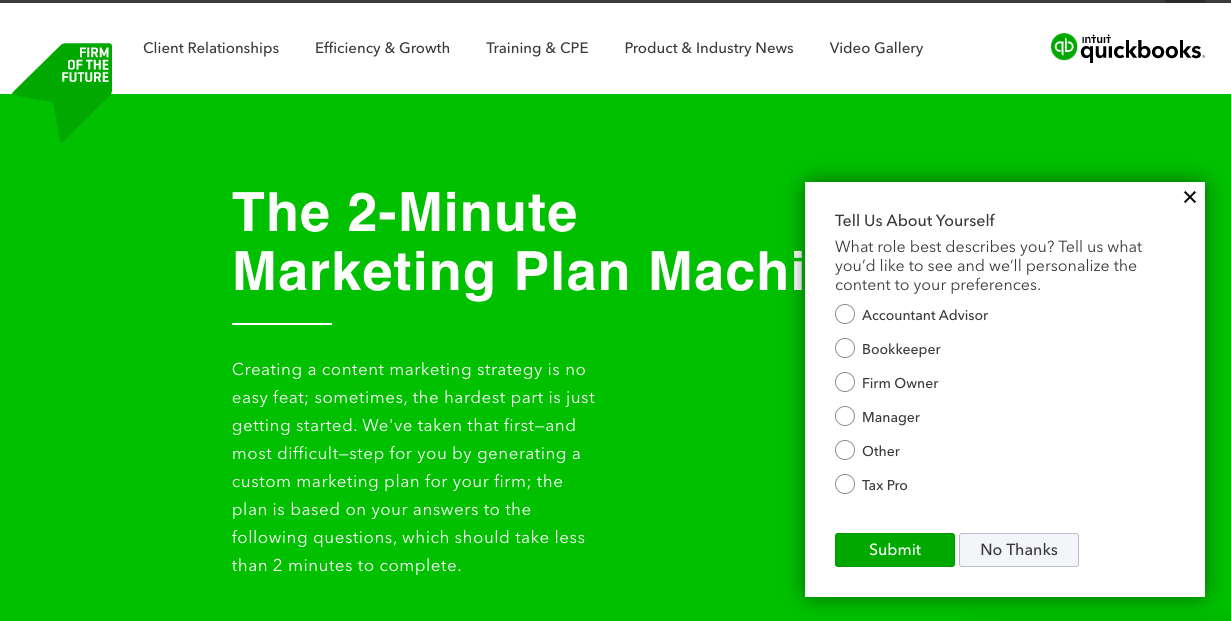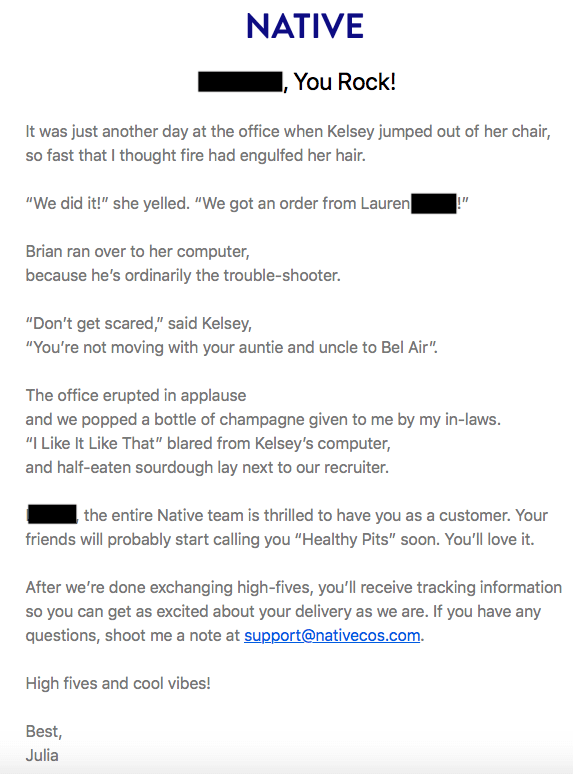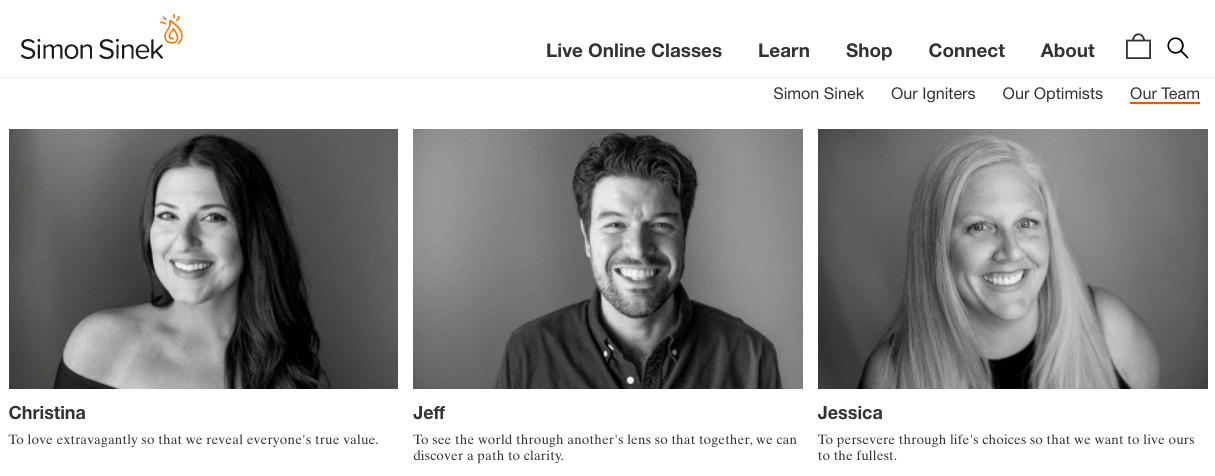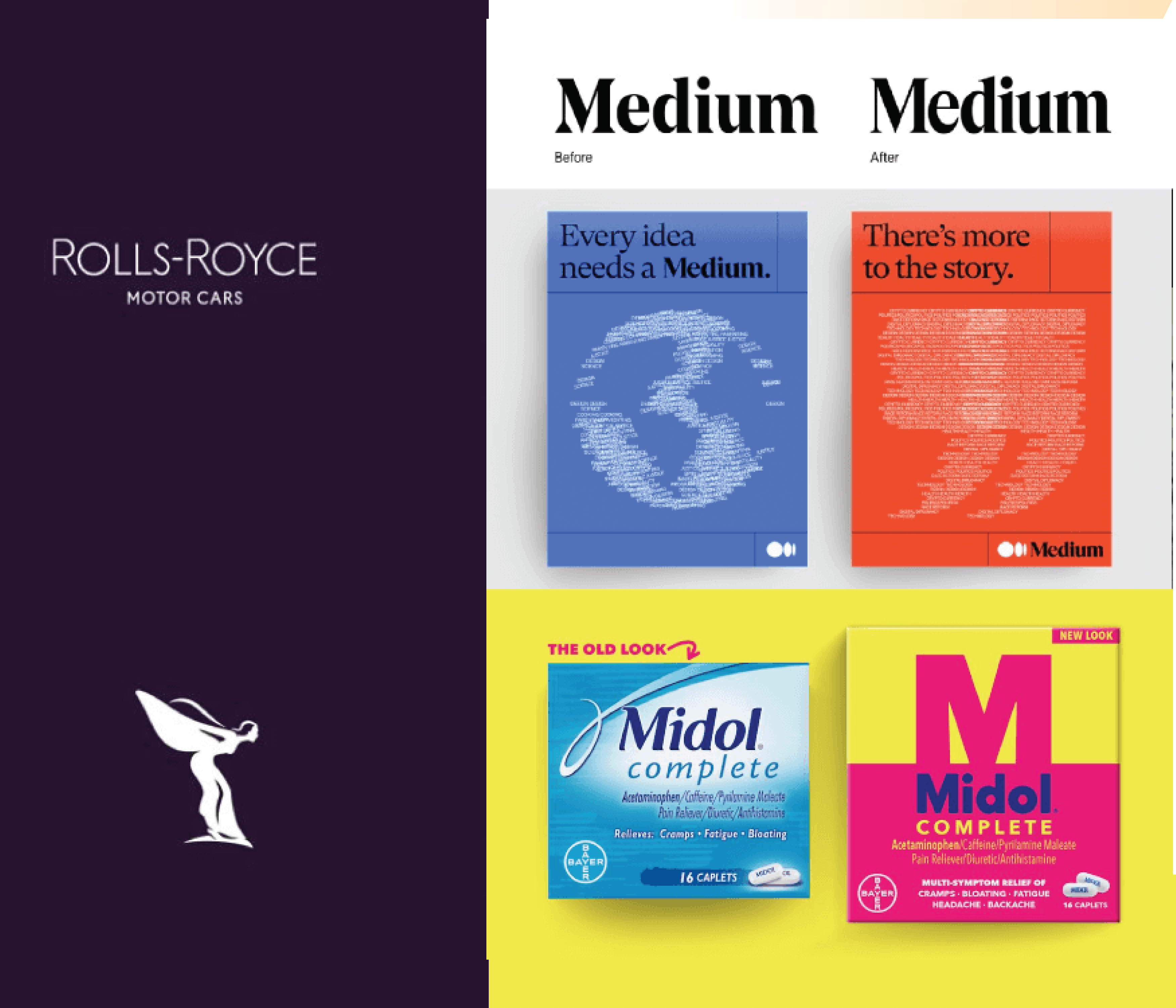According to Salesforce’s 2019 State of the Connected Consumer Report, 52% of consumers say companies are generally impersonal. We’d agree. Generic content is one of the biggest sins of content marketing, yet it’s also the most common.
We’ve all encountered boring corporate brands. Their emails sound like auto-generated nonsense. Their websites are littered with basic stock photography. Their social media has no personality. They have no humanity, yet they wonder why their content can’t capture and keep people’s attention.
Being human isn’t a marketing “strategy”; it’s the foundation of building a strong brand. The more earnest and authentic you are, the more meaningful your interactions become, and the better your brand experience will be. So how do you make sure you lead with your humanity? By telling strong stories in your content marketing.
How to Come Up with Great Content Marketing Ideas
From your website, to your newsletter, to your Instagram feed, you have plenty of opportunities to showcase your humanity through storytelling, connect with people on an emotional level, and cultivate a lasting relationship.
But we know that brainstorming the right ideas isn’t always easy. That’s why we’re making it easier. Here, we’ve rounded up some of the best ways to create human-centric content, along with real-life examples of how other brands have done it successfully. If you’re looking for inspiration, we hope you find it here. Let’s jump in.
1) Share your values.
We say this over and over because it matters. A strong brand starts with a strong Brand Heart (aka your purpose, vision, mission, and values). The better you can communicate your brand’s core principles, the more likely people will want to support you. (According to Salesforce, 80% of customers are more loyal to companies with good ethics.)
How to Do It
If you haven’t already, articulate your brand’s core principles using our free Brand Heart workbook, then brainstorm ideas that relate to each category: your purpose, vision, mission, or values. For more inspiration, look at how these brands put their values front and center.
Example: In honor of International Day Against Homophobia, Transphobia and Biphobia, Ikea created a new ad redefining the notion of what a loving home looks like.
2) Be vulnerable.
According to Salesforce, 54% of consumers say it’s harder than ever for a company to earn their trust. You can remedy that by providing transparency and honesty in your content marketing, especially when it comes to your vulnerabilities, mistakes, or failures. The more you open up, the more people can you see you as human and, ultimately, respect you.
How to Do It
If you made a mistake, make an earnest apology. If you failed but learned something important, turn it into a teachable moment. If it took you 100 tries to create the perfect product, show people the process.
That said, vulnerability and oversharing are not the same thing. If you’re not sure if your brand should talk about something, here are five questions to ask before you speak up.
Example: Hubspot’s Director of Marketing shared the top 10 mistakes she’s made in analytics, helping turn her failures into valuable lessons that other marketers can learn from.
3) Bring people together.
Creating community is one of the best ways to bring people into your brand story. When you can connect with people around shared interests, values, or challenges, you create a sense of belonging that helps people feel seen.
How to Do It
There are plenty of ways to do this as a brand—even if you can’t “meet” in real life. Host a virtual event, start an online group, do a Live Q&A with an industry expert, etc. It doesn’t have to be about customers either. You can also create community with your employees and your industry peers.
Example: Lululemon hosts 30-minute quick workouts on Instagram to keep their community fit and connected during quarantine.
4) Talk to people, not at them.
Interruption marketing is over. Engagement marketing is everything. If you want to be human, act human. Talk to people, ask them about themselves, find out what they’re interested in, what they care about, etc.
How to Do It
You can engage people in both small and large ways. Ask questions, create quizzes, have them weigh in on a new product, solicit tips, etc. Social is especially helpful for this, as things like Twitter polls or Instagram challenges make it easy to engage with people.
Example: Through a simple Instagram poll, Hubspot polled their followers about their biggest content marketing challenges.
What’s your biggest pain point with your current CMS?
— HubSpot (@HubSpot) May 15, 2020
5) Show off the humans behind your brand.
From your front desk, to R&D, to your warehouse, there are a lot of people that make your brand what it is. The more you peel back the curtain on who and what makes your brand unique, the more people will be compelled to engage with you. This is also a smart way to attract the type of people who will want to work for your brand.
How to Do It
Spotlight your people, jokes, events, mealtimes, celebrations, culture, process, or expertise. For more ideas, see our guide to culture marketing 101.
Example: In honor of Asian Pacific American Heritage Month, Zendesk employees found a unique way to celebrate.
To celebrate #APAHM, Zendesk employees put together a cookbook of Asian Pacific American inspired recipes. Cynthia Ma, a Software Engineer in our SF office, shared her recipe for Easy Tomato and Egg Stir Fry. ?#LifeatZendesk pic.twitter.com/tTjTLKMzur
— Zendesk (@Zendesk) May 14, 2020
6) Nurture your existing relationships.
A good brand is sustained by lasting relationships. But those relationships need to be tended to. Don’t get so laser-focused on getting new people through the door that you forget about the people who already work with and support your brand.
How to Do It
Check in with people, follow up, share helpful info or tools, send unexpected gifts. These small gestures can go a long way to strengthen your relationship.
Example: From salt-and-pepper shakers, to playing cards, to fine art prints, we send our clients unique gifts that reflect our values in some way. It’s a simple way to let our people know we’re thinking about them.

7) Create content that fills a need.
Empathy is a core human emotion, and one that serves brands well in marketing. The more you prove that you understand people and are truly invested in helping them, the more people will view your brand as a trusted resource.
How to Do It
Create content marketing that serves people’s needs, wants, or challenges. Things like tools, resources, checklists, e-books, tutorials, or how-tos are especially helpful. You can also check out these 10 ways to provide value in your content.
Example: Dropbox partnered with creative thinkers and makers to create digital care packages to help people explore their interests. From recipes to meditation, it’s a smorgasbord of entertainment and education.

8) Personalize where possible.
People want to feel seen and understood. Personalizing content is a simple way to make them feel that way. It may also be the difference between getting your emails read or not. According to Salesforce, 45% of consumers ignore communications from companies unless they’re personalized.
How to Do It
Map your buyer’s journey to address people’s needs at every stage. Use automation to personalize your communication. Look for ways to tailor recommendations or serve people’s specific needs. Also remember that it’s not just about personalizing things for other people. Any communication you send should also be from a specific person on your team. You’ll get bonus points if you include a photo, too.
Example: To help small accounting firms better market themselves, Intuit created The 2-Minute Marketing Plan Machine, which offers a customized marketing plan based on the user’s unique needs.

9) Share your brand’s origin story.
Nobody becomes an instant success overnight. It takes a strong vision and a lot of hard work to get there. In the spirit of transparency (and often, humility), telling the story of how you got started is a great way to connect with people.
How to Do It
Whether your brand was born of a specific event or a happy accident (as ours was), share the interesting anecdotes, travails, milestones, and experiences that made your brand what it is. Sharing your early failures can be endearing and inspiring, helping you showcase your perseverance, humanity, and creativity.
Example: In honor of our 10-year anniversary, we shared the origin story of how our founders created Column Five.
10) Use your human voice.
Honestly, this tip is found in pretty much every article on branding ever. But it bears repeating. Differentiating yourself is harder than ever—and more important than ever. Your brand voice is an easy way to infuse your content marketing with personality to help you stand out.
How to Do It
Think about who you’re speaking to and how they want to be spoken to. Don’t speak above them or below them. Don’t drown them in jargon. If you’re not sure how you should speak, follow our guide to identify your brand voice, and create brand guidelines to help others use it correctly, too.
Example: Native deodorant’s brand voice is so distinct and entertaining that they can turn a confirmation email into an entertaining journey.

11) Learn how to respond vs. react.
When you face challenges or make a mistake, you can’t hide behind a faceless corporate facade. You need to lead with your humanity. That said, you don’t just want your brand to be human; you want it to be a decent and responsible human. This is why it’s important to learn to thoughtfully and empathetically respond to things.
How to Do It
Make sure your actions and communications are always aligned to your Brand Heart. (This is why having your purpose, vision, mission, and values articulated is so important.) You can also follow these 4 tips to respond in any situation.
12) Use live-action video.
Video is a powerful medium that helps humans connect emotionally. Thanks to the phenomenon of emotional contagion, we actually empathize with what we see on screen. (This is why you feel physically scared when you watch a horror movie.) This makes video a great content marketing tool for brands.
How to Do It
The great news is that you can create great video even if you’re working remotely (here are 6 types of video you can do on your own). For more tips on everything from ideating, to scripting, to shooting, check out The Content Marketers Guide to Brand Video.
Example: To show solidarity with everyone stuck at home, our team created a collaborative video, edited together from footage shot on our personal smartphones.
13) Create a colorful About Us page.
One of the easiest ways to show people who you are is to vamp up your website’s About Page, Culture Page, or whatever you call it. This is often underused and overlooked real estate on a brand’s site, but it’s an important place to make the right impression. The more colorful or creative you get, the more people will feel connected to you.
How to Do It
Spruce up your page with team photos, quotes, personal anecdotes, punchy bios, etc. (Warning: Do not bore your viewers with page-long bios!)
Example: Marketing expert and motivational speaker Simon Sinek’s work is driven by the question “why?” Instead of individual bios, his team page lets every person answer their personal “why.” This is a simple, emotional, and memorable way to “meet” his team.

14) Ask for user-generated content.
If you want to bring people into your brand story, invite them to contribute to it directly. User-generated content is a great way to do this, and social platforms have made it easy to solicit. (BTW, a 2017 Elon University study found that 66.3% of consumers surveyed heavily rely on user generated-content when attempting to make purchasing decisions.)
How to Do It
There are plenty of creative ways to solicit UGC: photos, videos, caption contests, hashtags, interactive sites, etc. Note: a visual element is always a smart way to engage, as it lets people see each other’s contributions.
Example: Dove’s #WashtoCare campaign invited people to share the reasons why they’re washing their hands (and tag friends to do the same). It was a simple way to build community, spread public awareness, and generate personal content that resonates.
View this post on Instagram
15) Revamp your CTAs.
This is such a simple way to prove that you’re not a faceless robo-corporation. (The devil is in the details, after all.) Simple things like CTAs, product copy, or site headers can make a big difference in how your brand is perceived, so add as much personality as possible.
How to Do It
Audit your site with fresh eyes to see where you can tweak your CTAs, callouts, or other copy. (The same goes for adding more human-centric imagery to your site.) One note, though: While you want to add personality, remember that user experience matters. Your CTAs can be clever, but they should also be clear enough that people know how to contact you, download something, or shop your products. For more tips, find out how to write compelling copy that converts.
Example: Bedding brand Buffy does a great job of adding personality to every part of their site.

Remember: Story Is the Key to Connection
As you continue to refine your content strategy, look for more unique ways to bring your brand to life in every piece of content you create. If you need a few more ideas to get started…
- Learn about the keys to a strong brand story.
- Design a visual identity that accurately reflects your brand personality.
- Follow our guide to keep your content marketing on brand.
- Ask these questions to make sure your story idea will work.
But if you’re not sure what your brand story is (or how to tell it), bring in some expert help. Try these tips to find the right creative agency for you, or holler at us.




